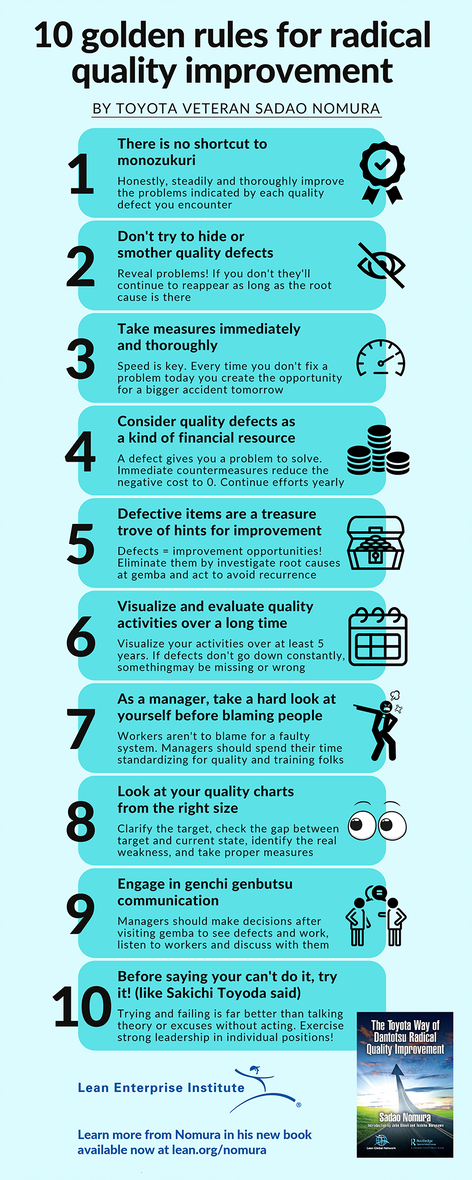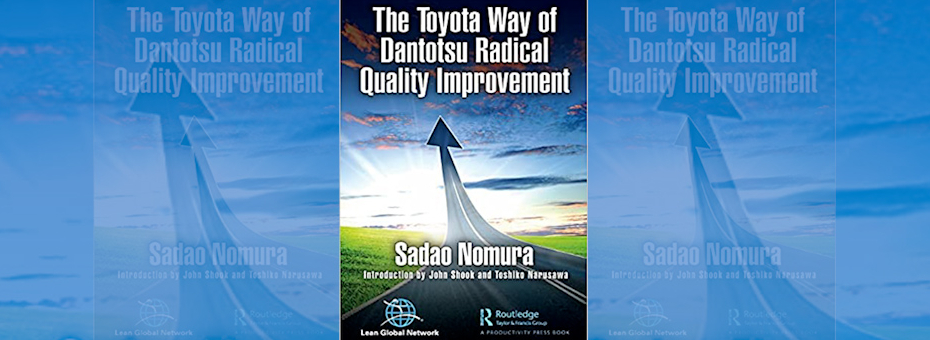Product quality is an area that no company should ever be satisfied with, whatever their metrics. Whether you’re reasonably happy with steady quality improvements or frustrated with the slow pace of them despite company-wide efforts, no company can afford to relax even the most relentless effort to improve quality.
But where must you focus, and how can you improve your quality improvement process?
 “Even if it is known that the poor quality is due to something missing or wrong with the current quality improvement efforts, it is not easy to identify the real cause,” notes Toyota Veteran Sadao Nomura in the introduction to his new book The Toyota Way of Dantotsu Radical Quality Improvement.
“Even if it is known that the poor quality is due to something missing or wrong with the current quality improvement efforts, it is not easy to identify the real cause,” notes Toyota Veteran Sadao Nomura in the introduction to his new book The Toyota Way of Dantotsu Radical Quality Improvement.
Nomura speaks from experience: He faced — or, more accurately, faced-down — this problem during his time at the Industrial Division of Toyota Industries Corporation. His book, based on this experience, shares “examples of activities that brought about significant effects on quality improvement,” according to Nomura. He writes that he hopes you will discover what you need to do to radically improve quality by comparing those activities with those of your company.
To get you started, here are 10 golden rules (download a pdf of the infographic here.) gleaned from the book by Roberto Priolo, managing editor of Planet Lean:
- There is no shortcut to monozukuri (making things)
Honestly, steadily, and thoroughly improve problems indicated by each quality defect you encounter. - Don’t try to hide or smother quality defects
Reveal problems! If you don’t, they’ll continue to reappear as long as the root cause is there. - Take measures immediately and thoroughly
Speed is key. Every time you don’t fix a problem today, you create the opportunity for a bigger accident tomorrow. - Consider quality defects as a kind of financial resource
A defect gives you a problem to solve. Immediate countermeasures reduce the negative cost to zero. Continue efforts yearly. - Defective items are a treasure trove of hints for improvement
Defects equal improvement opportunities! Eliminate them by investigating the root cause at the gemba and act to avoid recurrence. - Visualize and evaluate quality activities over a long time
Visualize your activities over at least five years. If defects don’t go down constantly, something may be missing or wrong. - As a manager, take a hard look at yourself before blaming people
Workers aren’t to blame for a faulty system. Managers should spend their time standardizing for quality and training folks. - Look at your quality charts from the right size
Clarify the target, check the gap between target and current state, identify the real weakness, and take proper countermeasures. - Engage in genchi genbutsu communication
Managers should make decisions after visiting the gemba to see defects and work, listen to the workers, and discuss with them. - Before saying you can’t do it, try it (like Sakichi Toyoda said)!
Trying and failing is far better than talking theory or excuses without acting. Exercise strong leadership in individual positions!
Learn more
Get the book that John Shook describes as “a story of remarkable quality improvement inside the world’s best quality manufacturer” in the LEI store.





